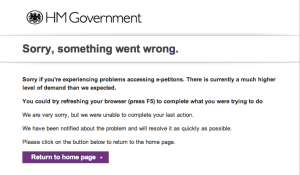It’s a week since the Government launched its e-petition website, so what have we learnt from the first 7 days?
Update 12/8 – 1,806 petitions have been added in the sites first week, of those 152 have gained only 1 signature and only 28 have gained more the 1,000.
1 – The site can’t cope with surges in traffic.
It was perhaps to be expected that the site would go down on the first day, indeed it’s almost a tradition for new government sites which have all failed to anticipate the number of people visiting. But it’s also been down for much of today (Wednesday) as people have surged to sign a petition to remove benefits from those convicted of rioting in London which has gained over 79,000 signatures very quickly. I’d be concerned that the site wouldn’t be able to cope if an organisation with big mailing list asked its supporters to take action by signing a petition.

2 – The social media integration isn’t that bad…
Each petition page has buttons that allow you to broadcast the petition via twitter, Facebook and Linkedin which is good to see, but as Pete Taylor points out that site could have gone much further suggesting designed should ‘build out the e-petition system as an API – an ‘API’ allows other pieces of software to access a system….organisations could feature the petitions on their websites and recruit activists to their own email and supporter databases at the same time’
3 – But finding a petition could be much easier
One of the most disappointing aspect of the site is the homepage, which list the petitions by most recent one put up as a default option and provides two other options which allow you to sort by title and number of signatures. The search function is satisfactory, and they’re also listed by department but it would have been nice to see other ways of finding petitions, and perhaps details of the latest, most signed and most signed in the last 24 hours detailed on the home page.
4 – It’s social media that’s driving traffic to the site.
Last Thursday was a great case study for this. The petition to bring back capital punishment, which had been championed by blogger Guido Fawkes was heavily trailed in the newspaper and TV but by the end of the day it’d only got 3,000 signatures.
Contrast that to a counter petition to retain the ban on capital punishment which was promoted almost exclusively on twitter until Newsnight covered it which got 6,000 in the first day. A week later it’s still well ahead of the supposedly ‘higher profile’ petition. Similarly, it looks like much of the traffic to the London rioting petition has come from Facebook/Twitter as the media hasn’t been interested in covering it, bit.ly suggests that its been shared over 65,000 times on Facebook.
5 – Those behind it are more agile than expected.
I wrote last week that one of my concerns was that it’d take 7 days for petitions to be approved, which would make it hard for petitions to capitalise on what’s happening in the media. Given that the first report of recent events in London came through on Saturday night, the London rioting petition shows that it’s possible for those working on it to turn around petitions quicker than that.
6 – I’m already a little bored of it.
As I write the top petitions are on very similar subjects to those that were around on the No10 petition site, it’s almost predictable and as yet it doesn’t seem to have generated any interesting new ideas for Parliament to debate.
This is perhaps in part down to the format that requires any petition to get over the 100,000 signature threshold, which means many campaigns will feel that they can’t make target but also the lack of flexibility in the system. I’m expecting some media coverage of the first petition that makes it over the 100,000 line and the first to be debated, but after that I’m not sure how much interest its going to generate.
What are your thoughts or reflections from the first week of the e-petition site?